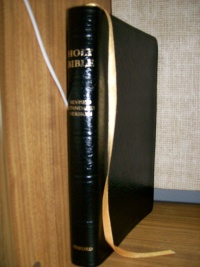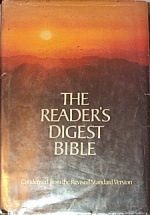Revised Standard Version
From Textus Receptus
The RSV was published in the following stages:
- New Testament, First Edition (1946; originally copyrighted to the International Council of Religious Education)
- Old Testament (and thus the full Protestant Bible) (1952)
- Apocrypha (1957)
- Modified Edition (only a few changes) (1962)
- Catholic Edition (NT 1965, Full RSV-CE 1966)
- New Testament, Second Edition (1971)
- Common Bible (1973)
- Apocrypha, Expanded Edition (1977)
- Second Catholic Edition (2006)
Contents |
Making of the RSV
In 1928, the copyright to the ASV was acquired by the International Council of Religious Education (ICRE), which renewed the copyright the next year. From 1930-32, a study of the ASV text was undertaken to decide the question of a new revision, but due to the Great Depression, it was not until 1937 that the ICRE voted in favor of revising the ASV text. A panel of 32 scholars was put together for that task. Also, the Council hoped to set up a corresponding translation committee in Great Britain, as had been the case with the RV and ASV, but this plan was canceled because of World War II.
Funding for the revision was assured in 1936 by a deal that was made with Thomas Nelson & Sons. The deal gave Thomas Nelson & Sons the exclusive rights to print the new version for ten years. The translators were to be paid by advance royalties.
The Committee determined that, since the work would be a revision of the "Standard Bible" (as the ASV was sometimes called because of its standard use in seminaries in those days), the name of the work would be the "Revised Standard Version".
The translation panel used the 17th edition of the Nestle-Aland Greek text for the New Testament, and the traditional Hebrew Masoretic Text for the Old Testament. However, they amended the Hebrew in a number of places. In the Book of Isaiah, they sometimes followed readings found in the newly discovered Dead Sea Scrolls.
The RSV New Testament was published on February 11, 1946. In his presentation speech to the ICRE, Luther Weigle, dean of the translation committee, explained that he wanted the RSV to supplement and not supplant the KJV and ASV.
In 1950, the ICRE merged with the Federal Council of Churches to form the National Council of the Churches of Christ in the USA. The former ICRE became the new Council's Division of Christian Education, and the NCC became the official sponsor of the RSV.
Translators
The 1952 Revised Standard Version (RSV) was a revision of the 1901 American Standard Version (ASV). Below are some excerpts from many of the translators.
- “Revelation has sometimes been understood to consist in a holy book. ...Even on Christian soil it has sometimes been held that the books of the Bible were practically dictated to the writers through the Holy Spirit. …I do not think that this is the distinctively Christian position.
(Clarence T. Craig, 1943, The Beginning of Christianity)
- “The mere fact that a tomb was found empty was capable of many explanations. The very last one that would be credible to a modern man would be the explanation of a physical resurrection of the body.” (Craig, Ibid.)
- “The writers of the New Testament made mistakes in interpreting some of the Old Testament prophecies.” (James Moffatt, 1921, The Approach to the New Testament)
- “One cannot of course place John on the same level with the synoptic Gospels [Matthew, Mark, Luke] as a historical source.” (William Albright, 1957, From the Stone Age to Christianity)
- “He [Jesus Christ] was given to overstatements, in his case, not a personal idiosyncrasy, but a characteristic of the oriental world.” (Henry F. Cadbury, 1962, Jesus, What Manner of Man?)
- “According to enthusiastic traditions which had come down through the folklore of the people of Israel, Methuselah lived 969 years.” (Walter Russell Bowie, Great Men of the Bible)
- “The story of Abraham comes down from ancient times; and how much of it is fact and how much of it is legend, no one can positively tell.” (Bowie, Ibid.)
- “We do not press that Gospel [John] for too great verbal accuracy in its record of the sayings of Jesus.” (Willard L. Sperry, 1943, Rebuilding Our World)
- “This phrase [‘Thus saith the Lord’] is an almost unfailing mark of spuriousness.” (William A. Irwin, 1943, The Problem of Ezekiel)
- “The narrative of calling down fire from heaven upon the soldiers sent to arrest him is plainly legendary” (Fleming James, 1934, The Beginnings of Our Religion)
- “What really happened at the Red Sea we can no longer know.” (James, Ibid.)
- “We cannot take the Bible as a whole and in every part as stating with divine authority what we must believe and do.” (Millar Burrows, 1946, Outline of Biblical Theology)
The Apocrypha and the Catholic Edition
Apocrypha
In 1957, at the request of the Episcopal Church in the United States of America, the Deuterocanonical books (called the Apocrypha by most Protestant Christians) were added to the RSV. Since there was no American Standard Version of the Apocrypha, the RSV Apocrypha was a revision of the Revised Version Apocrypha of 1894, as well as the King James Version. To make the RSV acceptable to Eastern Orthodox congregations, an expanded edition of the Apocrypha containing 3 and 4 Maccabees and Psalm 151 was released in 1977.
Most editions of the RSV that contain the Apocrypha place those books after the New Testament, arranged in the order of the King James Version (the Eastern Orthodox books in post-1977 editions are added at the end). The exception, of course, is the Common Bible, where the Apocryphal books were placed between the Testaments and rearranged in an order pleasing to Protestants, Catholics, and Orthodox alike (see below for more information about the Common Bible).
Catholic Edition
See Also Revised Standard Version Catholic Edition
In 1965, the Catholic Biblical Association adapted—under the editorship of Bernard Orchard OSB and Reginald C. Fuller—the RSV for Catholic use with the release of the Revised Standard Version Catholic Edition. The RSV-Catholic New Testament was published in 1965 and the full RSV-Catholic Bible in 1966. This included revisions up through 1962, along with a small number of new revisions in the New Testament, mostly to return to familiar phrases. In addition, a few footnotes were changed. This edition is currently published and licensed by Ignatius Press. It contains the deuterocanonical books of the Old Testament placed in the traditional order of the Vulgate.
The Catholic RSV was also used as the English text for the Navarre Bible commentary.
In 2006, Ignatius Press released the Revised Standard Version-Second Catholic Edition, which updated the archaic language in the 1966 printing and exchanged some footnotes and texts to reflect a more traditional understanding of certain passages, such as replacing "young woman" with "virgin" in Isaiah 7.14, as previously mentioned. (See also Ignatius Catholic Study Bible series)
Adaptations
There have been many adaptations of the RSV over the years.
Common Bible
The Common Bible of 1973 ordered the books in a way that pleased both Catholics and Protestants. It was divided into four sections:
- The Old Testament (39 Books)
- The Catholic Deuterocanonical Books (12 Books)
- The additional Orthodox Deuterocanonical Books (three Books; six Books after 1977)
- The New Testament (27 Books)
The non-deuterocanonicals gave the Common Bible a total of 81 books: it included 1 Esdras (also known as 3 Ezra), 2 Esdras (4 Ezra), and the Prayer of Manasseh, books that have appeared in the Vulgate's appendix since Jerome's time "lest they perish entirely", but are not considered canonical by Roman Catholics and are thus not included in most modern Catholic Bibles. In 1977, the RSV Apocrypha was expanded to include 3 Maccabees, 4 Maccabees, and Psalm 151, three additional sections accepted in the Eastern Orthodox canon (4 Maccabees again forming an appendix in that tradition). This action increased the Common Bible to 84 Books, making it the most comprehensive English bible translation to date in its inclusion of books not accepted by all denominations. The goal of the Common Bible was to help ecumenical relations between the churches.
Reader's Digest Bible
In 1982, Reader's Digest published a special edition of the RSV that was billed as a condensed edition of the text. The Reader's Digest edition of the RSV was intended for those who did not read the Bible or who read it infrequently. It was not intended as a replacement of the full RSV text. In this version, 55% of the Old Testament and 25% of the New Testament were cut. Familiar passages such as the Lord's Prayer, Psalm 23 and the Ten Commandments were retained. For those who wanted the full RSV, Reader's Digest provided a list of publishers that sold the complete RSV at that time.
See Also
- The Revised Standard Version Exposed by Ken Matto
External Links
Pro KJV Links
- The Revised Standard Version Exposed by By Dr. Ken Matto



